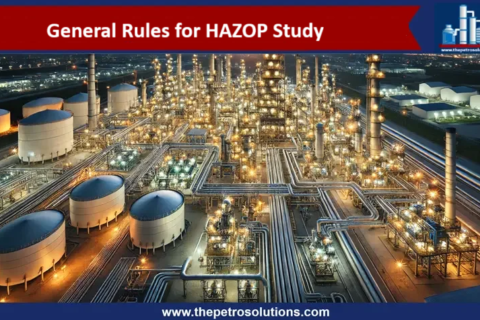Alkanolamines or amines are chemicals used for the removal of sour gases (H2S/CO2) from the industrial gas streams. Amines used are basic in nature and react with acid gases to form salts. This process of treatment of Acid gases with amines is called Amine Scrubbing, Acid Gas Treatment, Amine Gas Treatment, Gas Sweetening, or Acid Gas removal. Amines have a functional group that contains nitrogen. Primary amines arise when one of the three hydrogen atoms in ammonia is replaced with an organic substituent. Secondary amines have two organic components while tertiary amines have three organic substituents bonded with Nitrogen. The choice of amine depends on pressure, temperature, gas flow rate, gas composition, and purity requirements of the treated gas.
Many different amines are used in gas treating, major types are as follows;
- Monoethanolamine (MEA)
- Diethanolamine (DEA)
- Methyldiethanolamine (MDEA)
- Diisopropanolamine (DIPA)
- Aminoethoxyethanol (Diglycolamine) (DGA)
1. Monoethanolamine (MEA)
It is the primary, strongest, and the most basic amine among others. It can almost completely remove the acid gases from the gas stream. Used in low-pressure natural gas treatment applications required for stringent product gas specifications. These amines were used extensively for many years for the treatment of acid gases but now are rapidly being replaced by other efficient amines. It reacts with H2S and CO2 as follows;
2(RNH2) + H2S ↔ (RNH3)2S
(RNH3)2S + H2S ↔ 2(RNH3)HS
2(RNH2) + CO2 ↔ RNHCOONH3R
Disadvantages
- It irreversibly forms reaction products with carbonyl sulfide (COS) and carbon disulfide (CS2), which results in excessive solution loss and an increase of solid products in the circulating solution. These particles cause foaming in the amine solution.
- These are more corrosive in nature as compared to other amines, particularly if the amine concentration exceeds 20 % or the solution is highly loaded with acid gas. So, the high partial pressure of acid gas limits its capacity.
- Requires large circulation rates and high energy consumption.
- It bears relatively higher vapor pressure causing significant vapor losses.
- More prone to degradation during normal operation.
- It has a high heat of reaction with CO2/H2S and requires high energy for regeneration.
Applications
It is still preferred for gases having low concentrations of CO2/H2S and where carbonyl sulfide (COS) and carbon disulfide (CS2) are not present. Further, when the gas stream is at low pressure and maximum H2S/CO2 removal is required.
2. Diethanolamine (DEA)
Diethanolamine (DEA) has replaced Monoethanolamine (MEA) and becoming the most widely used gas sweetening solvent because of its overwhelming advantages over Monoethanolamine (MEA). It can treat gases in the presence of COS and CS2 and also can be regenerated when reacts with carbonyl sulfide (COS) and carbon disulfide (CS2). Because of fewer corrosion problems and the high efficiency of acidic gas removal, it is the predominant chemical being used in refineries. It is a secondary amine with lower reactivity and corrosivity than Monoethanolamine (MEA). The basic reactions with CO2 and H2S are the same as Monoethanolamine (MEA).
2R2NH + H2S ↔ (R2NH2)2S
(R2NH2)2S + H2S ↔ 2R2NH2SH
2R2NH + CO2 ↔R2NCOONH2R2
Advantages
- It has a lower vapor pressure so minor solution loss. It has lesser heat of reaction, therefore, is easier to regenerate than MEA.
- Loading up to 0.65 mol of acid gas per mole of DEA can be achieved with fewer operational problems than MEA because of the elimination of the degradation products.
- It is a weaker base and less reactive in comparison to MEA. Therefore, fewer corrosive problems despite twice the solution strength of MEA.
- Foaming is reduced due to the absence of degradation and corrosion products.
- Do not degrade when in contact with H2S, CO2, or mercaptans.
- Lower circulation rates, reduced energy consumption, and resistance to degradation, as opposed to MEA.
- Under normal operating conditions, DEA decomposition products can be removed quite easily by filtration through activated carbon.
- DEA (Secondary Amine) is much less reactive with carbonyl sulfide (COS) and carbon disulfide (CS2) than primary amines (MEA) and the reaction products are not corrosive. Therefore, DEA is a better choice for the treatment of gas streams that contain carbon disulfide (CS2)/CO2.
- It can be used equally for high and low-pressure applications.
Disadvantages
- DEA undergoes numerous irreversible reactions with CO2 that form corrosive degradation products, therefore, DEA may not be the optimum choice for treating gases with high CO2 content.
Applications
- DEA is used to treat natural gas, refinery off-gases, recycle gases of hydrotreating and hydrocracking units, liquefied petroleum gas (LPG), and off-gases of the refinery before being sent to the refinery fuel gas system.
- DEA process has been widely used for the treatment of high-pressure natural gases with high concentrations of acidic components, especially if carbonyl sulfide (COS) and carbon disulfide (CS2) is also present in a considerable quantity.
Methyldiethanolamine (MDEA)
MDEA is a good choice for the selective absorption of H2S in the presence of CO2. Reduced weight percent solutions are typically used in low-pressure and selective gas applications. Corrosion is much decreased even under high acid gas loadings. Its principal disadvantage is its slow reaction to CO2. MDEA is used in the purification of non-hydrocarbon gases such as the products from coal gasification processes and Claus plant tail gas treatment section.
- The overwhelming advantage of MDEA is its high selectivity for H2S in the presence of CO2.
- Other merits of MDEA include low vapor pressure, lesser heat of reaction, and higher resistance to thermal and chemical degradation.
- Because of its low vapor pressure, MDEA can be used in concentrations up to 60 wt% in aqueous solutions without considerable evaporation losses.
- It is essentially non-corrosive and has low specific heat and heat of reaction with H2S and CO2.
Disadvantages
- In the presence of oxygen, MDEA forms corrosive acids which, if not removed can result in an accumulation of iron sulfide in the system.
- Generally, MDEA reactivity is less reactive and may not meet treated product specifications at low gas pressures.
- It is a tertiary type amine and cannot react directly with CO2. When CO2 is dissolved in water, a Bi-carbonium ion is formed that reacts with MDEA. Therefore, less efficient to remove CO2. MDEA is less reactive in comparison to DEA or MEA.

Diglycolamine (DGA)
The solvent comes in the category of primary amines. In many respects is similar to monoethanolamine (MEA), except that its low vapor pressure permits its use in relatively high concentrations (40~60 %). High concentration, results in lower circulation rates and steam consumption in contrast to MEA. DGA has proven to be very effective for purifying large volumes of low-pressure acid gases.
Advantages
- DGA can operate at high ambient temperatures and can treat acid gas at moderate pressures.
- It has low capital and operating cost, as well as improved operation at relatively low pressures as opposed to MEA.
- It can partially remove carbonyl sulfide (COS) and a sufficient portion of DGA can be recovered by steam distillation, from the degradation products produced by the reaction of DGA with CO and carbonyl sulfide (COS).
- Despite high concentrations, it does not cause corrosion in comparison to other amines.
- High concentration of solution, requires low rates, less steam requirement for regeneration, and high acid gas loading as opposed to MEA.
Diisopropanolamine (DIPA)
DIPA is a secondary amine and has been used for the treatment of refinery and natural gas streams. It is used most frequently in the ADIP process of acid gas treatment licensed by Shell. At low pressure, DIPA is more selective towards H2S, and at higher pressures, it removes both CO2 and H2S. With the right design, DIPA systems are also capable of moderate selectivity toward H2S in the presence of CO2.
Advantages
- DIPA reacts with carbonyl sulfide (COS) and carbon disulfide (CS2) and the products can easily be regenerated.
- It is non-corrosive and also requires less heat for the regeneration of rich amine.
- DIPA is very resistant to degradation. Carbon and particulate filtration are usually sufficient to maintain a clean solution.
Applications
DIPA is used to treat Claus Sulfur Recovery Unit tail gas streams, refinery gases, and liquified petroleum gas (LPG) streams, Mercaptans removal, especially when carbonyl sulfide (COS) is present.
Mixed Amines
Mixed Amines are generally mixtures of MDEA and Diethanolamine (DEA) or Monoethanolamine (MEA) and are used to enhance CO2 removal by MDEA. The addition of primary or secondary amines, such as MEA and DEA, has been found to enhance the rate of CO2 absorption significantly without declining MDEA’s many advantages. Such mixtures are called MDEA-based amines. At lower MEA and DEA concentrations, the overall amine strength can be as high as 55% (wt), without causing corrosion problems.
Amine mixtures are particularly useful for low-pressure applications because MDEA becomes less capable of CO2 removal. At higher pressures, amine mixtures appear to have little or no advantage over MDEA. Another useful feature of mixed amine is that the formulation can be varied to meet specific site requirements.
References
- Petroleum and Gas Field Processing BY H. K. Albdel-Aal, Mohamed Aggour, M.A. Fahim
- Gas Purification by Arthur 1. Kohl Richard B. Nielsen, Fifth Edition
Certified Functional Safety Professional (FSP, TÜV SÜD), Certified HAZOP & PHA Leader, LOPA Practitioner, and Specialist in SIL Verification & Functional Safety Lifecycle, with 18 years of professional experience in Plant Operations and Process Safety across Petroleum Refining and Fertilizer Complexes.
- Nasir Hussainhttps://thepetrosolutions.com/author/admin/
- Nasir Hussainhttps://thepetrosolutions.com/author/admin/
- Nasir Hussainhttps://thepetrosolutions.com/author/admin/
- Nasir Hussainhttps://thepetrosolutions.com/author/admin/






